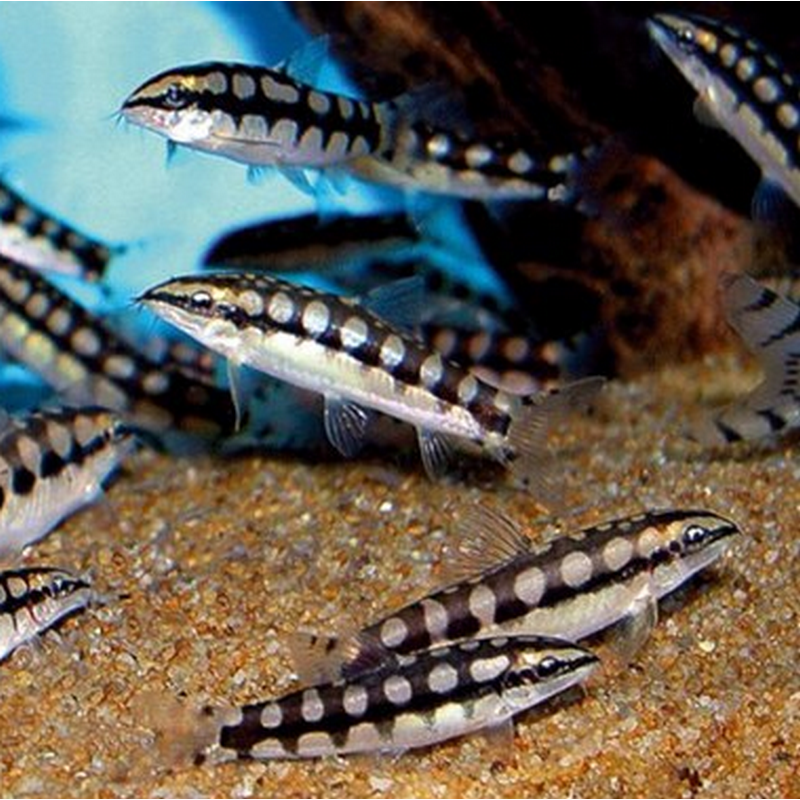Next working day delivery with Royal Mail Tracked 24
Description
Dwarf Chain Loach
The Dwarf Chain Loach (Yasuhikotakia sidthimunki) is also known as the ladderback loach, pygmy loach, or chain botia, and is native to the Mae Klong basin (including Khwae Noi River) in Thailand, and the Ataran River on the Thai-Myanmar border. The Dwarf Chain Loach species is considered to be
endangered in its native Thailand, but is now captive-bred on a large
scale in the far East.
Dwarf Chain Loaches are an ideal choice for the smaller peaceful aquarium community, and will thrive in a shoal. Dwarf Chain Loach have delicate barbels, so a sandy substrate is recommended with plenty of hiding places such as caves, bog wood, and aquatic plants.
Do Dwarf Chain Loaches eat snails?
The Dwarf Chain Loach, like most loaches, often preys on tiny shrimp and snails. This can be very useful in helping reduce pest snails, but not ideal if you keep larger ornamental snails and shrimp.
Please be aware that the image is for illustration purposes only. Unless stated, we are unable to guarantee the exact size, colour, sex or age of the fishes you are purchasing. If you have any questions regarding livestock please contact us. To minimise stress we are unable to hand-pick specific. Lifespan is an estimate based on optimum conditions.
Features
Approx. size: 3cm
Maximum size: 3"
Origin: Thailand
Family: Botiidae
Temperament: Peaceful
Lighting requirement: Low
Ideal number kept together: 5+
Water conditions
Our conditions: pH 7.5
Ideal pH: 6.0–7.5
Hardness: low/moderate (8 dGH)
Water flow: moderate/high
Temperature: 25–30 °C
Ease of care
Easy. Will thrive in a larger shoal of 5 or more. Requires fine substrate and plenty of hiding places.
Diet
Omnivore - The main food we recommend would be blood worm, small granules, flake and other sinking food. Mixing in some live or frozen brine, or other fresh alternatives
can help enhance their health.
Compatibility
Peaceful. Dwarf Chain Loaches have been known to eat snails (pest and otherwise) and shrimp.
Breeding
Egg layers. Not very common in captivity.
Life Span
They can live to 5+ years in perfect conditions.
For more information on general fishkeeping and our shipping procedures click here.
Shipping Cut Off Times
- In stock orders placed before on working weekdays before 2pm will be despatched on the same working weekday.
- In stock orders placed on a Saturday before 10am will be despatched on that Saturday.
- Orders that include pre-order items will be shipped together in total once the pre-order items arrive back in stock using the delivery service chosen at checkout.
None of these cut-offs apply to palletised items, pond plants or fibreglass ponds.
| SERVICE | SPEND | COST |
| Packet/Courier items | ||
| Royal Mail Next Day (1-2 days) | £0.00-£49.99 | £3.99 |
| DPD Local Next Day (1 day) | £0.00-£49.99 | £6.99 |
| DPD Local Saturday | £0.00-£49.99 | £14.99 |
| DPD Local Sunday | £0.00-£49.99 | £14.99 |
| DPD Local Next Day (1 day)*** | £50 and up | FREE |
| DPD Local Saturday | £50 and up | £9.99 |
| DPD Local Sunday | £50 and up | £9.99 |
| Pallets (booked in) | aquariums / bulky items | |
| Pallets Standard (3-5 days) | - | FREE |
| Pallets Express (1-2 days) | - | £39.99 |
| *EXCLUDED ITEMS | extra delivery fees apply | |
| Fibreglass Ponds (booked in) | ||
| Zone 1 (7-10 days) | - | £79.99 |
| Zone 2 (7-14 days) | - | £149.99 |
| Zone 3 (7-21 days) | - | £249.99 |
| Pond Plants (direct from grower) |
||
| All pond plants (3-10 days) | one-off fee regardless of order size/value | £5.99 |
***Orders with a value between £50 and £80 that are under 2kg in weight may be sent via a Royal Mail Next Day Signed for service.
Further delivery information
All delivery services are working day services and do not include delivery on Saturdays and Sundays or public holidays as standard.
Deliveries are usually Monday to Friday only, although some Royal Mail items may be delivered on weekends as standard if the service is available in your area.
Orders over £50 delivering to non UK mainland locations may be despatched via a Royal Mail (2-3 days) service rather than an express shipping option.
Please see our full delivery information page and terms and conditions for detailed information on shipping policies and zones


